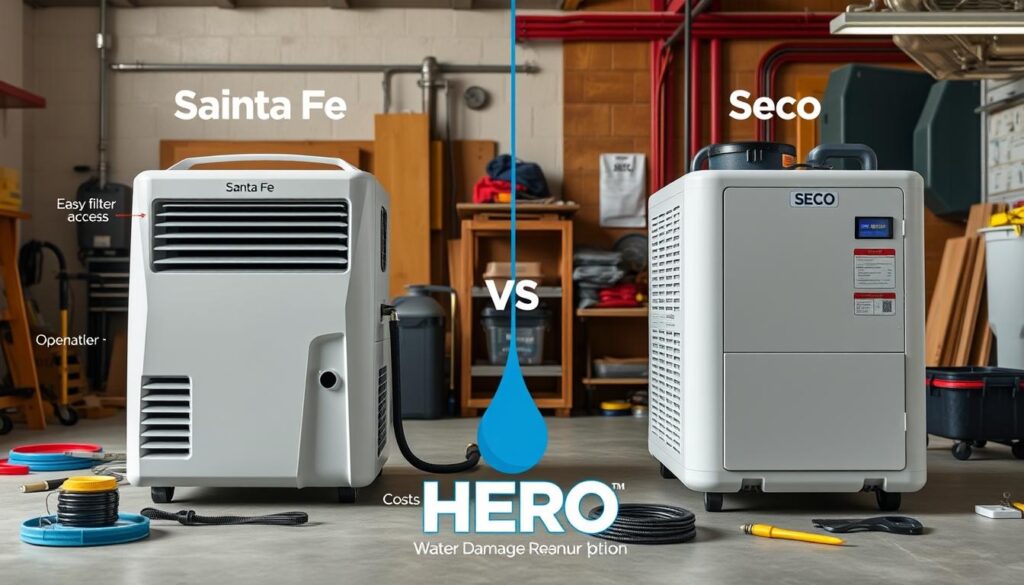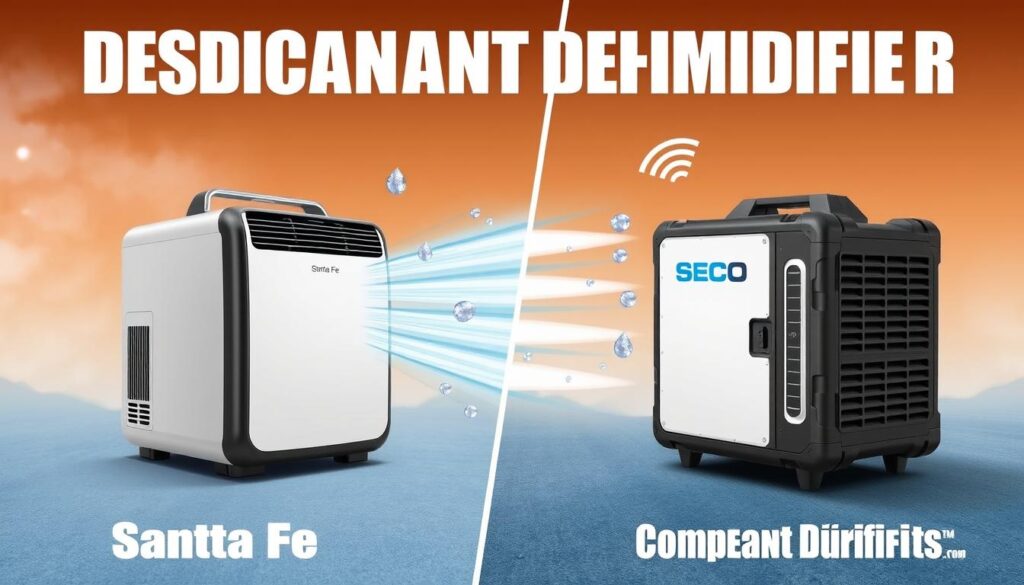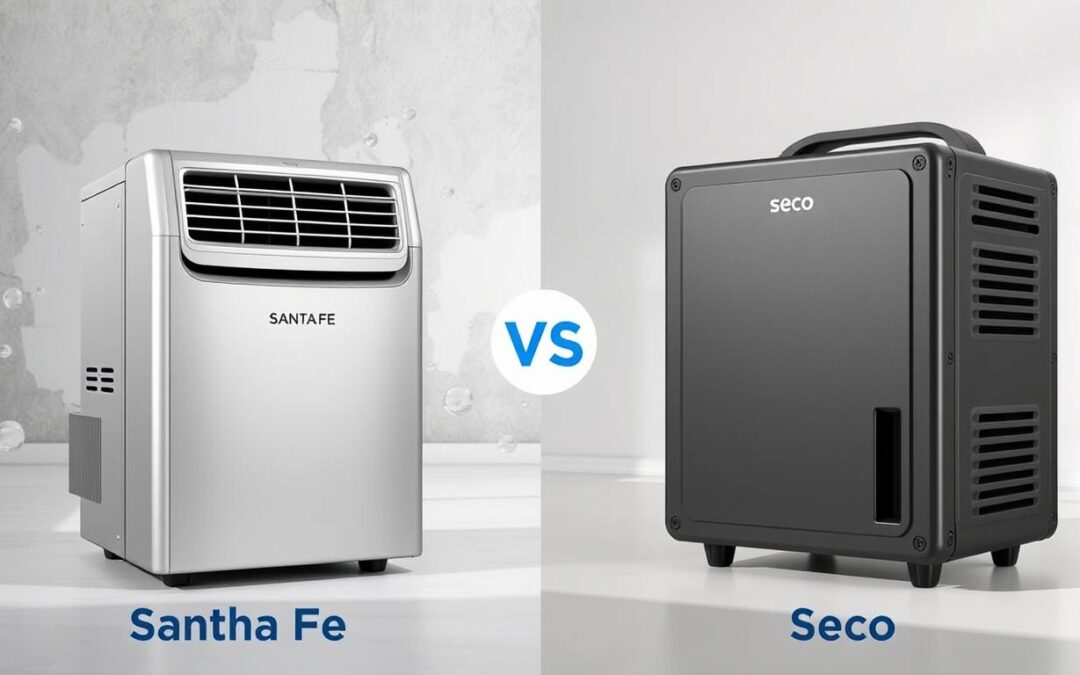Desiccant dehumidifiers are changing how we control indoor climate. They remove moisture better than ever before. But, Santa Fe and Seco are the top names in this field. Which one really delivers on promises of efficiency, reliability, and cost-effectiveness? Let’s look at what makes them different.
Key Takeaways
- Comparison of Santa Fe and Seco desiccant dehumidifiers for performance, energy efficiency, and value.
- Examination of advanced desiccant technology used by both brands to remove moisture from the air.
- Insights to help consumers make an informed decision based on their specific needs and environmental conditions.
- Detailed analysis of features, capabilities, and user experience for both Santa Fe and Seco desiccant dehumidifiers.
- Comprehensive evaluation to determine the superior desiccant dehumidifier between the two leading brands.
Understanding Desiccant Dehumidification Technology
Desiccant dehumidifiers use special materials called desiccants to pull moisture from the air. These materials love water molecules, so they grab and hold onto humidity. Unlike regular dehumidifiers, desiccant systems work differently. This makes them great for specific uses.
How Desiccant Materials Work
The heart of a desiccant dehumidifier is the desiccant wheel or rotor. It’s a slowly moving part covered in desiccant like silica gel or lithium chloride. When air goes through the wheel, it picks up moisture from the desiccant.
Then, the wheel gets heated. This makes the moisture it held onto come out and leave the system.
Key Components of Desiccant Systems
- Desiccant Wheel or Rotor: The rotating structure coated with desiccant materials that adsorbs moisture from the air.
- Heater: Responsible for heating the desiccant wheel to regenerate the desiccant materials and release the trapped moisture.
- Fans: Circulate the air through the desiccant wheel and expel the dehumidified air.
Benefits Over Traditional Dehumidifiers
Desiccant dehumidifiers have big advantages over regular systems. They work best in cooler temperatures, which is perfect for places that need low humidity. They also use less energy because they don’t need the cooling process that regular dehumidifiers do.
“Desiccant dehumidifiers are a game-changer in the world of moisture control, offering enhanced performance and efficiency compared to their compressor-based counterparts.”
Desiccant dehumidifiers are a top pick for places where regular dehumidifiers can’t keep humidity levels right. Their special materials and design make them stand out.
Santa Fe vs Seco Desiccant Dehumidifiers: Direct Comparison
Two top brands, Santa Fe and Seco, lead in desiccant dehumidifiers. They use different methods to remove moisture, each with its own benefits. Let’s compare them to see how they compare.
| Feature | Santa Fe | Seco |
|---|---|---|
| Desiccant Material | Silica gel | Polymer-based desiccant |
| Airflow Capacity | Up to 200 CFM | Up to 400 CFM |
| Moisture Removal Rate | Up to 90 pints per day | Up to 120 pints per day |
| Operating Temperature Range | 40°F to 100°F | 35°F to 100°F |
| Energy Efficiency | ENERGY STAR certified | Varies by model |
| Noise Level | Relatively quiet operation | Slightly louder than Santa Fe |
| Portability | Compact and lightweight design | Larger and heavier units |
| Ductwork Compatibility | Easily integrated into existing ductwork | Requires dedicated ductwork installation |
Looking at the table, Seco dehumidifiers have higher airflow and moisture removal rates. But Santa Fe systems are more energy-efficient and quieter. Santa Fe also fits better into existing ductwork, making them versatile.
Choosing between Santa Fe and Seco depends on your project’s needs. Both brands are reliable but have different strengths.
Performance Metrics and Moisture Removal Capacity
The Santa Fe and Seco brands are top choices for desiccant dehumidifiers. It’s key to look at their performance and how well they remove moisture. Let’s see what makes them stand out.
Operating Temperature Range
The temperature range is important for dehumidifiers. The Santa Fe works well from 33°F to 125°F. The Seco does best in colder temperatures, from 40°F to 100°F.
Daily Moisture Removal Rate
Both Santa Fe and Seco remove a lot of moisture each day. The Santa Fe can take out up to 100 pints. The Seco can remove up to 90 pints. They’re great for places with a lot of humidity.
Energy Efficiency Ratings
Being energy-efficient is important. The Santa Fe has high ratings and some are Energy Star certified. The Seco also uses energy well, helping to save on costs.
| Metric | Santa Fe | Seco |
|---|---|---|
| Operating Temperature Range | 33°F to 125°F | 40°F to 100°F |
| Daily Moisture Removal Rate | Up to 100 pints | Up to 90 pints |
| Energy Efficiency Ratings | Energy Star Certified | Efficient Operation |
Knowing how the Santa Fe and Seco dehumidifiers perform helps you choose the right one. They offer great options for keeping your space dry and comfortable. Whether you care most about temperature, moisture, or energy use, these brands have you covered.
Design Features and Build Quality Analysis
Choosing a desiccant dehumidifier means looking at design and build quality. Santa Fe and Seco offer different options to fit your needs.
Santa Fe dehumidifiers are built tough. They have a heavy-duty steel cabinet for commercial use. The blower and rotor are reliable, even in tough conditions. They also have a coating to fight off moisture damage.
Seco dehumidifiers are smaller and lighter. They’re great for homes and small businesses. They’re not as heavy-duty as Santa Fe, but they’re still reliable for a long time.
| Design Feature | Santa Fe | Seco |
|---|---|---|
| Cabinet Material | Heavy-duty steel | Lightweight, corrosion-resistant plastic |
| Durability | Highly durable, suitable for commercial and industrial applications | Moderately durable, suitable for residential and smaller commercial use |
| Corrosion Resistance | Corrosion-resistant coating | Minimal corrosion resistance |
| Noise Level | Moderate noise levels | Quieter operation |
| Portability | Heavier and less portable | Lighter and more portable |
Choosing between Santa Fe and Seco depends on your needs. Look at design and build quality to pick the best for you.
Installation Requirements and Space Considerations
When choosing the best desiccant dehumidifiers, Santa Fe and Seco have different needs. Homeowners and managers need to think about these carefully. This ensures the units work well and last long.
Ducting Options
The Santa Fe and Seco dehumidifiers come with flexible ducting. The Santa Fe needs 8-inch or 10-inch ducts. Seco works with 6-inch or 8-inch ducts. It’s important to measure the space and airflow to pick the right size.
Placement Guidelines
Where you place the santa fe review and seco review dehumidifiers matters a lot. They should be in well-ventilated spots, away from sunlight and heat. Also, make sure there’s enough room for airflow and maintenance. Talking to an HVAC expert can help find the best spot.
Electrical Requirements
The electrical needs of Santa Fe and Seco dehumidifiers vary. They usually need a 120V or 240V circuit with the right amperage. Always check the specs and talk to an electrician to make sure your setup can handle it.
Knowing about ducting, placement, and electrical needs helps choose the right dehumidifier. This ensures they fit well in your home or business.
Maintenance and Operating Costs
Desiccant dehumidifiers have maintenance needs and costs that matter a lot. Homeowners and businesses need to think about these when choosing. The Santa Fe and Seco models have different benefits that affect their use over time.
Filter Replacements
Both Santa Fe and Seco dehumidifiers need filter changes to work well. The Santa Fe’s filters should be swapped out every 6-12 months. Seco’s might need more frequent changes, based on how often you use it and your environment.
Energy Efficiency
How much energy a dehumidifier uses affects its cost. Santa Fe dehumidifiers use less power than Seco ones. This means Santa Fe users might save money on their bills every month.
Maintenance Procedures
Both brands give clear instructions on how to keep their dehumidifiers running smoothly. It’s important to clean them regularly and store them right when not in use. This helps them last longer.

Knowing about the upkeep and costs of Santa Fe and Seco dehumidifiers helps you choose wisely. Think about these costs, along with how well they work and their design. This way, you can make a smart choice for controlling humidity efficiently and reliably.
User Experience and Customer Reviews
Choosing the best desiccant dehumidifier means looking at user experience and customer reviews. Both Santa Fe and Seco brands have caught attention. They offer different features and capabilities. Let’s explore what customers say about these machines.
Noise Levels
Noise level is key when using a dehumidifier. The Santa Fe and Seco models are known for being quiet. Many users say they don’t disturb their daily life.
They find the noise levels as good as or better than traditional dehumidifiers. This makes them great for homes or offices.
Ease of Use
It’s important for appliances to be simple and easy to use. Both Santa Fe and Seco models get high praise for their controls and operation. Users find it easy to set humidity levels and empty the tank.
Customer Support Quality
Good customer support is crucial for a positive experience. Both Santa Fe and Seco have excellent support teams. Customers appreciate the quick help and solutions they get.
Overall, the feedback on Santa Fe and Seco desiccant dehumidifiers is very positive. They are known for their performance, ease of use, and support. These insights can help you choose the right desiccant dehumidifier for your needs.
Price Point Analysis and Value Proposition
When you’re looking to buy a desiccant dehumidifier, Santa Fe and Seco stand out. They have different prices and benefits. Knowing these can help you choose the best deal for your money.
Santa Fe dehumidifiers cost more at first, from $1,500 to $2,500. But their advanced tech and better moisture removal are worth it. They’re also very energy-efficient, saving you money on bills in the long run.
| Feature | Santa Fe | Seco |
|---|---|---|
| Initial Purchase Price | $1,500 – $2,500 | $1,000 – $1,800 |
| Energy Efficiency | ENERGY STAR® rated | Varies |
| Moisture Removal Capacity | Higher | Moderate |
| Warranty | 5-7 years | 1-5 years |
Seco dehumidifiers are cheaper upfront, from $1,000 to $1,800. They might not be as efficient or remove moisture as well as Santa Fe. But, they’re a good choice if you’re watching your budget.
Choosing between Santa Fe and Seco depends on what you need and can afford. Santa Fe offers top-notch performance for a higher price. Seco is more affordable, making it a good option for those who want value without breaking the bank.

Conclusion
After comparing the Santa Fe and Seco best desiccant dehumidifiers, we see they have different strengths. The Santa Fe is great for removing moisture and works well in many temperatures. It’s perfect for big spaces or places with a lot of humidity.
The Seco dehumidifier is known for saving energy and being easy to use. It’s a good choice for those who want to save money and find a simple solution.
Choosing between the santa fe vs seco depends on what you need. If you have a big space or need to control moisture a lot, the Santa Fe might be best. But if you want to save energy and find something easy to use, the Seco is a better fit.
Both the Santa Fe and Seco desiccant dehumidifiers keep humidity levels just right. They make your home or office comfortable and safe from too much moisture. You can trust either one to keep your space dry and comfortable.
FAQ
What are the key differences between Santa Fe and Seco desiccant dehumidifiers?
How do desiccant dehumidifiers work compared to traditional compressor-based systems?
What are the key performance metrics to consider when comparing Santa Fe and Seco dehumidifiers?
How do the design features and build quality of Santa Fe and Seco dehumidifiers compare?
What are the installation requirements and space considerations for Santa Fe and Seco dehumidifiers?
What are the maintenance requirements and operating costs associated with Santa Fe and Seco dehumidifiers?
How do user experiences and customer reviews compare between Santa Fe and Seco dehumidifiers?
How do the pricing structures and value propositions of Santa Fe and Seco dehumidifiers compare?
Source Links
- improve stone passage: Topics by Science.gov
- Search Results for "Punch pressOn-site"
- hot arid climates: Topics by Science.gov
- "Green" Hotels Association – Newsletter Lead Articles
- Moisture Control in Buildings – PDF Free Download
- What does BHB stand for?
- cabin humidity condensate: Topics by Science.gov
- CV
- Bazile D. (ed.), Bertero H.D. (ed.), Nieto C. (ed.). 2015. State of the art report on quinoa around the world in 2013. Roma (Italy) : FAO, 589 p
- (Microsoft Word – José_Rui.doc)
- GreenLatin.pdf
